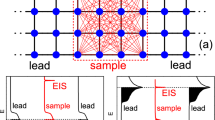Abstract.
A semi-phenomenological theory of variable-range hopping (VRH) is developed for two-dimensional (2D) quasi-one-dimensional (quasi-1D) systems such as arrays of quantum wires in the Wigner crystal regime. The theory follows the phenomenology of Efros, Mott and Shklovskii allied with microscopic arguments. We first derive the Coulomb gap in the single-particle density of states, g(ε), where ε is the energy of the charge excitation. We then derive the main exponential dependence of the electron conductivity in the linear (L), i.e. σ(T) ∼exp [-(TL/T)γL], and current in the non-linear (NL), i.e. \(j({\mathcal E}) \sim \exp[-({\mathcal E}_{NL} / \mathcal{E})^{\gamma_{NL}}]\), response regimes (\({\mathcal E}\) is the applied electric field). Due to the strong anisotropy of the system and its peculiar dielectric properties we show that unusual, with respect to known results, Coulomb gaps open followed by unusual VRH laws, i.e. with respect to the disorder-dependence of TL and \({\mathcal E}_{NL}\) and the values of γL and γNL.
Similar content being viewed by others
References
N.F. Mott, W.D. Towse, Adv. Phys. 10, 107 (1961)
V.L. Berezinskii, Sov. Phys. JETP 38, 620 (1974)
A.A. Gogolin, V.I. Mel'nikov, E.I. Rashba, Sov. Phys. JETP 42, 168 (1976)
T. Giamarchi, H.J. Schulz, Phys. Rev. B 37, 325 (1988)
C.L. Kane, M.P.A. Fisher, Phys. Rev. B 46, 15233 (1992)
I.V. Gornyi, A.D. Mirlin, D.G. Polyakov, Phys. Rev. Lett. 95, 046404 (2005)
D.M. Basko, I.L. Aleiner, B.L. Altshuler; e-print arXiv:cond-mat/0506617
N.F. Mott, E.A. Davis, Electronic Processes in Non-Crystalline Materials, 2nd edn. (Clarendon Press, Oxford, 1979)
B.I. Shklovskii, A.L. Efros, Electronic Properties of Doped Semiconductors (Springer, New York, 1984)
The dimension 1 is special, see reference FTS for details
T. Giamarchi, Quantum Physics in One Dimension (Oxford Science Publications, 2004)
A.O. Gogolin, A.A. Nersesyan, A.M. Tsvelik, Bosonization Approach to Strongly Correlated Systems (Cambridge, 1999)
In a pure 2D system, there is only quasi-long-range order. We will however still use the terminology: CDW throughout the manuscript. As the system is strongly disordered there is no long-range order at all anyway (and it would be the same in the equivalent 3D geometry)
M.M. Fogler, S. Teber, B.I. Shklovskii, Phys. Rev. B 69, 035413 (2004)
F.J. Himpsel et al., J. Phys.: Condens. Matter 13, 11097 (2001)
G. Grüner, Density Waves in Solids (Addison-Wesley, New York, 1994); G. Grüner, Rev. Mod. Phys. 60, 1129 (1988)
Semiconductors and Semimetals 27: Highly Conducting Quasi-One-Dimensional Organic Crystals , edited by E. Conwell (Academic Press, San Diego, 1988)
ECRYS-2005: International Workshop on Electronic Crystals, edited by S. Brazovskii, N. Kirova, P. Monceau, J. Phys. IV France, 131 (EDP Sciences, 2005)
It should be noticed that going beyond the Mott or ES arguments or proving from microscopics the VRH laws are still open and challenging problems. However, progress has been made towards deriving the Coulomb gap shape, see reference MI.
M. Müller, L.B. Ioffe, Phys. Rev. Lett. 93, 256403 (2004)
For quasi-1D systems the parameter of the VRH law reads: T0 = 1/νξx ξy, where ξx ∝vF τel is the longitudinal, i.e. parallel to the chains, localization length and ξy is the transverse localization length. Assuming ξy ≤b, where b is the inter-chain distance and with ν∝1/vF b, one has: T0 ∝1 / τel, up to a numerical factor
J. Joo, S.M. Long, J.P. Pouget, E.J. Oh, A.G. MacDiarmid, A.J. Epstein, Phys. Rev. B 57, 9567 (1998)
A.N. Aleshin, S.R. Williams, A.J. Heeger, Synth. Met. 94, 173 (1997)
B. Zawilski, T. Klein, J. Marcus, Solid State Commun. 124, 39 (2002)
G. Blatter, M.V. Feigel'man, V.B. Geshkenbein, A.I. Larkin, V.M. Vinokur, Rev. Mod. Phys. 66, 1125 (1994)
S. Brazovskii, T. Nattermann, Advances in Physics 53, 177 (2004)
This follows from the fact that in quasi-1D systems, charges are constrained to move along lines, with a small hopping amplitude from one line to the other. For the Wigner crystal, where displacements are two-dimensional, the basic defect is the vacancy or the interstitial, with a length of the order of the distance between electrons
S. Brazovskii, N. Kirova, in Soviet Scientific Reviews, Sec. A, Physics Reviews, Vol. 6, edited by I.M. Khalatnikov (Harwood, New York, 1984)
Yu Lu, Solitons and Polarons in Conducting Polymers (World Scientific, 1988)
The f-scattering term is generally removed by a shift of the ϕ-field. One then works on the background of a deformed system. Here, we are interested in such deformations and we therefore consider explicitly the f-scattering term.
M.J. Rice, J. Bernasconi, Phys. Rev. Lett. 29, 113 (1972)
S.A. Brazovskii, S.I. Matveenko, Sov. Phys. JETP 72, 492 (1991)
V.L. Nguen, Sov. Phys. Semicond. 18, 934 (1984)
A.I. Larkin, P.A. Lee, Phys. Rev. B 17, 1596 (1978)
M. Fabrizio, A.O. Gogolin, S. Scheidl, Phys. Rev. Lett. 72, 2235 (1994)
S.I. Matveenko, S.A. Brazovskii, Phys. Rev. B 65, 245108 (2002)
B.I. Shklovskii, Sov. Phys. JETP 34, 108 (1972)
S.V. Malinin, T. Nattermann, B. Rosenow, Phys. Rev. B 70, 235120 (2004)
L.V. Keldysh, JETP Lett. 29, 658 (1979)
Author information
Authors and Affiliations
Corresponding author
Rights and permissions
About this article
Cite this article
Teber, S. Variable-range hopping in 2D quasi-1D electronic systems. Eur. Phys. J. B 49, 289–304 (2006). https://doi.org/10.1140/epjb/e2006-00078-0
Received:
Published:
Issue Date:
DOI: https://doi.org/10.1140/epjb/e2006-00078-0




